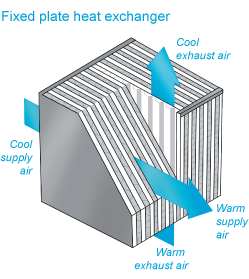​​​​​Fixed Plates
Reuse conditioned air and save
The low cost of plate technology has made it an increasingly popular choice for energy recovery systems. Plates are most widely used for small to medium-sized applications. Since they typically need to be large to accommodate higher air flow rates, they are generally space-prohibitive for larger applications. Their efficiency ranges from 50 to 80 percent and air streams can be arranged in parallel, cross-flow or counterflow patterns.
How it works
Plate technology uses layers of static plates which are sealed into either cross-flow or counterflow patterns to
 accommodate the intake and exhaust air streams. Because the plates are separated and sealed, there is minimal or no crossover contamination between air streams. This technology uses face and bypass dampers to control capacity. There are two types of plates, fixed plates and membrane plates. Plates are available as stand alone, with or without blowers, or as complete packages. One of the benefits of the technology is their static design makes them easy to clean. However, both plate systems require filtration to prevent plugging of the air passages.
accommodate the intake and exhaust air streams. Because the plates are separated and sealed, there is minimal or no crossover contamination between air streams. This technology uses face and bypass dampers to control capacity. There are two types of plates, fixed plates and membrane plates. Plates are available as stand alone, with or without blowers, or as complete packages. One of the benefits of the technology is their static design makes them easy to clean. However, both plate systems require filtration to prevent plugging of the air passages.
Fixed plate units, also known as
heat recovery ventilators are sensible devices consisting of alternate layers of plates, which are usually made of aluminum. The aluminum allows for easy temperature transfer, without transferring humidity. Steel alloy construction can also be used depending on the application � some can accommodate temperatures exceeding 400� F. Since there is minimal leakage between air streams, fixed plate technology is ideal for applications where the exhaust air is poor or foul, such as for stack economizers and process dryers. Because frosting on plate type energy recovery units can occur at approximately 25� F, a means for defrosting should be installed such as face and bypass dampers or an auxiliary heat source. A condensation removal system is also recommended.
Membrane plates, also known as
energy recovery ventilators or
membrane energy recovery ventilator units have the ability to transfer moisture as well as recover energy. The static plates are constructed of permeable membranes made of cellulose, polymers or other synthetic membranes. The plates transfer energy and moisture while minimizing air leakage. When selecting a membrane-type fixed plate, the desired amount of humidity to be captured should be included in the air properties calculation.
​